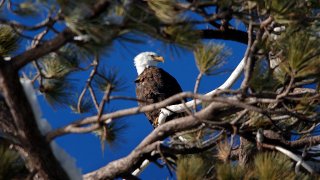
Two men killed about 3,600 birds, including bald and golden eagles, during a “killing spree” on Montana's Flathead Indian Reservation and elsewhere, then sold eagle parts on a black market that has been a long-running problem for U.S. wildlife officials, a federal grand jury indictment says.
The men worked with others to hunt and kill the birds, according to the indictment, and in at least one instance used a dead deer to lure in an eagle that was shot. The two defendants conspired with others who weren't named to sell eagle feathers, tails, wings and other parts for “significant sums of cash” across the United States and elsewhere, the indictment said.
Simon Paul, 42, of St. Ignatius, Montana and Travis John Branson, 48, of Cusick, Washington, face 13 counts of unlawful trafficking of bald and golden eagles and one count each of conspiracy and violating wildlife trafficking laws.
Text messages obtained by investigators showed Branson and others telling buyers he was “on a killing spree” to collect more eagle tail feathers for future sales, according to the indictment that described Paul as a “shooter” for Branson.
We've got the news you need to know to start your day. Sign up for the First & 4Most morning newsletter — delivered to your inbox daily. >Sign up here.
The indictment said the killings began in January 2015 and continued until 2021 near Ronan, Montana, on the Flathead Reservation, home of the Confederated Salish and Kootenai Tribes. It did not say how many of the 3,600 birds killed were eagles.
Illegal shootings are a leading cause of golden eagle deaths, according to a recent government study.
“We just hope that if these individuals are proven guilty that it will serve as a warning to others that we are watching,” said Rich Janssen, director of the tribes' Natural Resources Department. He said that members of the tribes use eagle feathers for traditional dress and in honor ceremonies.
U.S. & World
The day's top national and international news.
Tribal law enforcement was involved in the investigation of Paul and Branson, but Janssen did not know why it so long for them to be charged.
Bald eagles are the national symbol of the United States, and both bald and golden eagles are widely considered sacred by American Indians. U.S. law prohibits anyone without a permit from killing, wounding or disturbing eagles or taking any parts such as nests or eggs. Even taking feathers found in the wild can be a crime.
Federally recognized tribes can apply for permits with the U.S. Fish and Wildlife Service to take a bald or golden eagle for religious purposes, and enrolled tribal members can apply for eagle feathers and other parts from the National Eagle Repository. But there's a lengthy backlog of requests, according to Janssen and two independent eagle researchers.
The researchers said that backlog could be driving the black market for eagle parts. Feathers from young golden eagles are especially in high demand, with waits as long as five years to receive them from the repository, said researcher Bryan Bedrosian with the Teton Raptor Center in Wilson, Wyoming.
“It has kind of created this market unfortunately” for illegal eagle parts, he said.
Addressing those delays could help reduce the illegal trade in eagle parts, said Rob Domenech, executive director of Raptor View Research Institute in Missoula, Montana.
He said the area where the birds were allegedly being shot has some of the highest concentrations of eagles and other large raptors in the U.S. West. That includes breeding hawks and eagles and other birds that migrate from the north to winter in the Flathead area.
“It's basically a raptor bonanza at certain times of year, which would make it ripe for this type of activity,” Domenech said.
U.S. Fish and Wildlife officials did not immediately respond to questions regarding the backlog of permit requests from tribes. A spokesperson for Montana U.S. Attorney Jesse Laslovich, whose office is prosecuting the case, declined to comment beyond what was in the indictment.
Bald eagles were killed off across most of the U.S. last century, due in large part to the pesticide DDT, but flourished under federal protections and came off the endangered species list in 2007. Their population has been rapidly increasing in recent years. Golden eagle populations are less secure, and researchers say shootings, energy development, lead poisoning and other problems have pushed the species to the brink of decline.
There are an estimated 346,000 bald eagles in the U.S., versus about 40,000 golden eagles, which need much larger areas to survive and are more inclined to have trouble with humans.
Widespread illegal eagle killings last decade brought federal investigations that resulted in criminal convictions against 17 defendants from several states and two South Dakota pawn shops. In that case, the inspected bird parts were bought and sold over the internet, including in Iowa, Montana, Nebraska, South Dakota and Wyoming.
Earlier this year a Montana man was sentenced to three years in prison after prosecutors in South Dakota said he sold golden eagle tails for several hundred dollars each.
The grand jury indictment unsealed last week alleges Branson traveled from Washington state to the Flathead Reservation to shoot the eagles.
“When Branson arrived on the Flathead Indian Reservation, Paul would meet and help kill, transport, and ship bald and golden eagles for future sales on the black market,” the indictment states.
Paul and Branson were not in custody and were issued summons to appear for arraignments on Jan. 8 in U.S. District Court in Missoula.
Court documents did not name attorneys for the men, and they could not be immediately reached at telephone numbers listed for them.
___
Associated Press writer Sarah Brumfield in Washington, D.C., contributed to this story.



